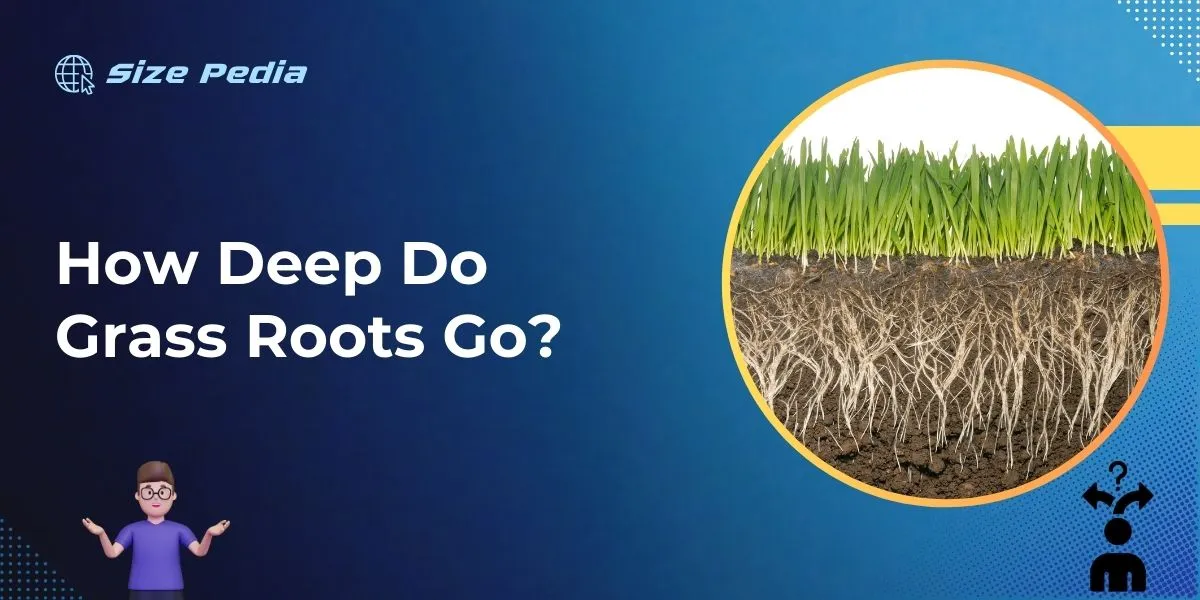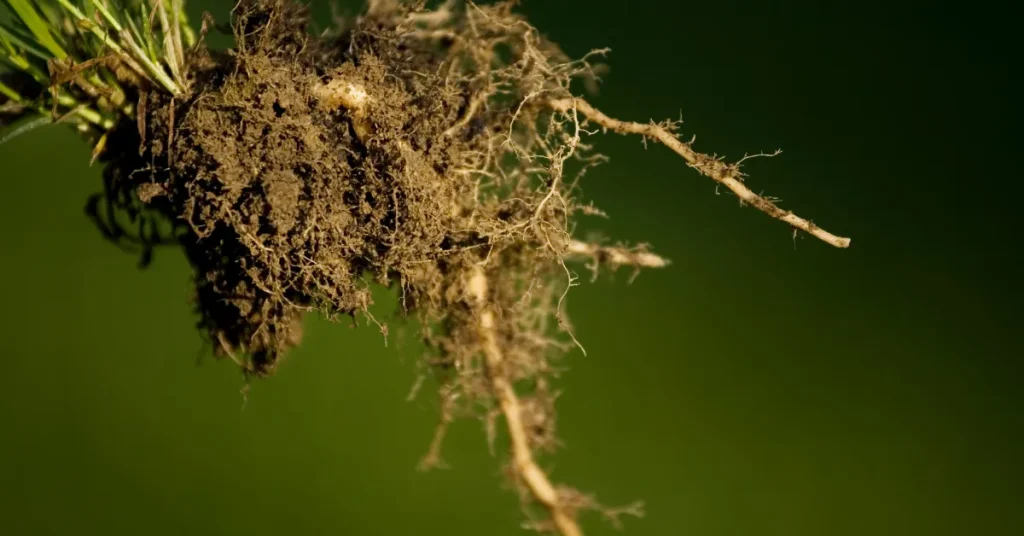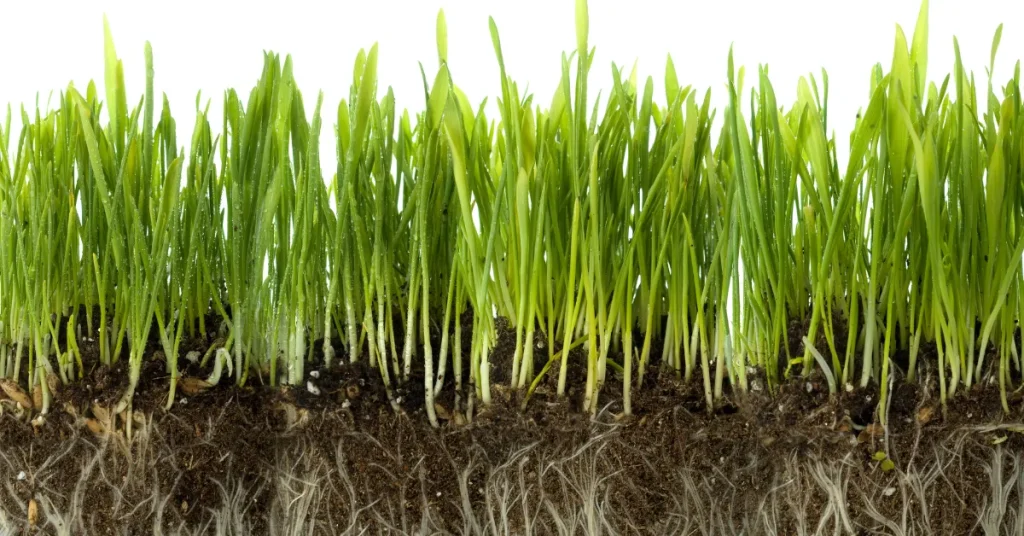Grass roots typically reach depths of 2 to 6 inches, but some grasses can grow roots up to 60 inches deep. The depth varies by grass species and environmental conditions.
Grass roots play a crucial role in the health and stability of your lawn. Deep root systems help grass to withstand drought, absorb nutrients, and anchor the soil to prevent erosion.
Shallow roots, on the other hand, make the turf more vulnerable to stress and less efficient in water and nutrient uptake.
Understanding the rooting depth of your grass can influence watering practices, fertilization, and overall lawn maintenance strategies.
A well-rooted lawn not only looks lush and green but also contributes to a healthier ecosystem by facilitating soil aeration and supporting beneficial microorganisms.

The Hidden World Beneath Our Feet
Imagine a bustling city beneath your lawn. Grass roots create a complex world underground. Much like a city’s foundation, these roots support and nourish life above. Let’s dig into this hidden realm and unveil the wonders of grass root systems.
The Significance Of Grass Roots
Grass roots are vital to our planet’s health. They are nature’s anchors, securing soil in place. Their web-like structure filters water and absorbs nutrients. This network provides a habitat for microorganisms too.
These tiny creatures help our environment in big ways. They break down organic matter and recycle nutrients back to the soil. This unseen action keeps our earth rich and ready for growth.
- Soil stabilization: Roots prevent erosion by holding soil.
- Water management: They soak up rainfall, reducing runoff.
- Nutrient uptake: Roots grab essential minerals for the grass.
A Journey To The Earth’s Underworld
Embark on a journey deep into the earth’s underworld. The depth of grass roots can vary widely. Some stay shallow, while others reach several feet down. The conditions determine how deep they go.
This underground adventure reveals different root depths:
- Shallow roots: In clay or compact soil, roots may only go a few inches.
- Medium depth: With adequate conditions, they can reach a foot.
- Deep divers: Some grass types in ideal soil can go down several feet.
Grass type matters:
| Grass Type | Root Depth |
| Bermuda Grass | Deep |
| Rye Grass | Shallower |
| Fescue | Medium to Deep |
Water plays a key role. Enough water encourages roots to grow deeper. They search for moisture and nutrients in the soil. This quest strengthens grass against drought.
Soil condition is another factor. Looser, fertile soil lets roots expand freely. They thrive and dig deeper into the earth.
Imagine, just beneath our feet, roots are crafting a world unseen. Yet, it’s an integral part of our environment. Next time you step onto your lawn, recall the secret world below. It keeps your grass green and our earth stable.
Grass Species And Root Depths
Did you know that the depth of grass roots can vary widely depending on the species? This plays a crucial role in how well your lawn can survive in different conditions.
Some grass types dig deep into the earth, while others spread just below the surface. Let’s delve into the fascinating world of grass roots and discover how different species have adapted through their root systems.
Root Range Variations
Grasses exhibit a diverse range in root depths, often driven by their native climates and soil types. Understanding these variations is key to optimizing lawn health and ensuring your grass has the resilience to withstand drought, nutrient deficiencies, and other stressors.
Examples By Grass Type
Let’s put a spotlight on different grass types and their characteristic root depths:
| Grass Type | Average Root Depth |
| Kentucky Bluegrass | 12-24 inches |
| Bermuda Grass | 60-72 inches |
| Buffalo Grass | 3-5 inches |
| Tall Fescue | 24-36 inches |
| Ryegrass | 6-14 inches |
Kentucky Bluegrass, famous for its beautiful lush appearance, typically extends roots up to two feet. In contrast, Bermuda Grass impresses with roots that can go down to a remarkable six feet, making it a champion in drought tolerance.
Meanwhile, Buffalo Grass roots stay relatively shallow, demonstrating efficiency in nutrient and water absorption from the top layer of soil.
Factors Influencing Grass Root Depth

The depth of grass roots can significantly impact a lawn’s health and resilience. Understanding the factors that influence root depth is crucial for proper lawn care. These factors range from the soil’s quality to climate conditions.
Soil Quality And Composition
Soil quality plays a pivotal role in root expansion.
- Clay soils can limit root growth due to density.
- Sandy soils allow deeper root penetration but may lack nutrients.
- A balanced mix of sand, silt, and clay, known as loam, promotes optimal root development.
Improving soil with organic matter can enhance root depth.
Water Availability
Roots chase after moisture to thrive.
- Frequent, light watering encourages shallow roots.
- Deep, infrequent watering promotes root depth.
An irrigation schedule must adapt to current weather patterns.
Climate Conditions
Temperature and seasons alter root behavior.
- High temperatures may stress grass, inhibiting root growth.
- Grass typically develops deeper roots in cooler seasons.
Protecting lawns from extreme heat can sustain root systems.
Measuring Roots: Techniques And Challenges
Understanding how deep grass roots grow is key to promoting healthy lawns. However, measuring root depth presents unique challenges. Traditional methods have evolved over time, and new technologies offer exciting possibilities.
Excavation And Observation
Excavation and observation have long been the root-study staples. This means gently digging up soil to expose roots. Scientists then measure and document the root depths.
- Soil samples: Researchers take various soil samples at different depths.
- Root washing: Soil is washed away to reveal root structures.
- Observation trenches: Large trenches are dug to study root profiles.
These techniques are labor-intensive and can disturb the very roots they measure. However, they provide invaluable baseline data.
Technological Advances In Root Mapping
New techniques reduce the need for digging and offer more insight into the underground world of grass roots.
- Ground Penetrating Radar (GPR): Uses radar pulses to create images of root depths.
- Electrical resistivity: Charts differences in soil conductivity caused by roots.
- Minirhizotron cameras: Tiny cameras that take pictures of roots in soil.
These advances allow for non-invasive root study. They give detailed root images without disrupting the lawn.
Impacts Of Deep Roots On Ecosystems

Understanding how deep grass roots grow sheds light on their role in our environment. Grass roots, often diving deeper than we see, anchor an intricate web of life below the ground. Deep roots impact ecosystems in ways that are vital for their health and longevity.
Soil Stability And Erosion
Grasses with deep root systems are nature’s answer to soil stability. These root networks hold soil particles tight, preventing them from washing away.
This is especially important on slopes and riverbanks where erosion can cause serious damage. A strong root system means a stronger foundation for various ecosystems.
- Reduces runoff during heavy rains
- Protects topsoil from being blown away by wind
- Supports other plant species by maintaining soil integrity
The Role Of Roots In Carbon Sequestration
Deep grass roots play a critical role in carbon sequestration. They absorb carbon dioxide from the air, which is used in photosynthesis.
The roots then store carbon underground, a process that reduces greenhouse gases. This makes grasslands important carbon sinks.
| Activity | Carbon Impact |
| Photosynthesis | Reduces CO2 |
| Root growth | Stores carbon |
| Decomposition | Returns nutrients |
Healthy deep roots ensure the continuous cycle of carbon absorption and storage. This positively affects global climate change mitigation efforts.
Caring For Grass Roots
Caring for grass roots ensures a lush, green lawn that stays healthy year-round. Grass roots can extend deep, but their well-being hinges on proper care. Explore how depth and care intersect to create an ideal environment for your lawn.
Best Practices For Lawn Maintenance
A beautiful lawn starts below the surface. For strong roots, the best practices include:
- Regular watering: Roots need moisture to grow deep. Water deeply but infrequently.
- Mowing: Cut grass at the recommended height to prevent stress on roots.
- Aeration: This allows oxygen to reach the root zone, encouraging deeper growth.
- Nutrition: Feed your lawn with the right fertilizer to nourish roots.
Innovative Approaches To Root Health
Embrace innovative approaches to boost root health:
- Soil Amendments: Enhance soil quality to promote root expansion.
- Microbial Inoculants: Use beneficial microorganisms to improve root environment.
- Root Stimulants: Apply products that specifically target root growth stimulation.
Remember, a focus on roots means a resilient, beautiful lawn from the ground up.
FAQs About How Deep Do Grass Roots Go
How Deep Can Grass Roots Typically Grow?
Grass roots can typically grow 4-6 inches deep in the soil. However, some deep-rooted species can extend several feet below the surface. Proper watering and soil conditions significantly affect root depth.
What Factors Influence Grass Root Depth?
Factors affecting root depth include soil type, grass species, watering habits, and climatic conditions. Compacted soil or inadequate watering can limit root expansion. Conversely, well-aerated soil promotes deeper growth.
Can Mowing Height Affect Root Depth?
Yes, mowing height can affect root depth. Taller grass often means deeper roots, as grass will grow its roots as deep as its blades are tall. Therefore, cutting grass too short can hinder root growth.
Does Fertilizing Impact Grass Root Systems?
Fertilizing can impact grass root systems positively by providing essential nutrients that encourage stronger, deeper growth. However, over-fertilizing may harm the roots, so it’s important to follow recommended rates and schedules.
Conclusion
Exploring grass root depths reveals a surprisingly intricate world beneath our feet. Different species dig down to varied lengths, influenced by soil, moisture, and climate factors.
Recognizing these dynamics can lead to healthier lawns and gardens. By nurturing our green spaces, we ensure stronger, more resilient plant life.
Dive into your yard’s care with this knowledge as your guiding tool.
Resources:
1. https://www.irs.gov/charities-non-profits/direct-and-grass-roots-lobbying-defined
